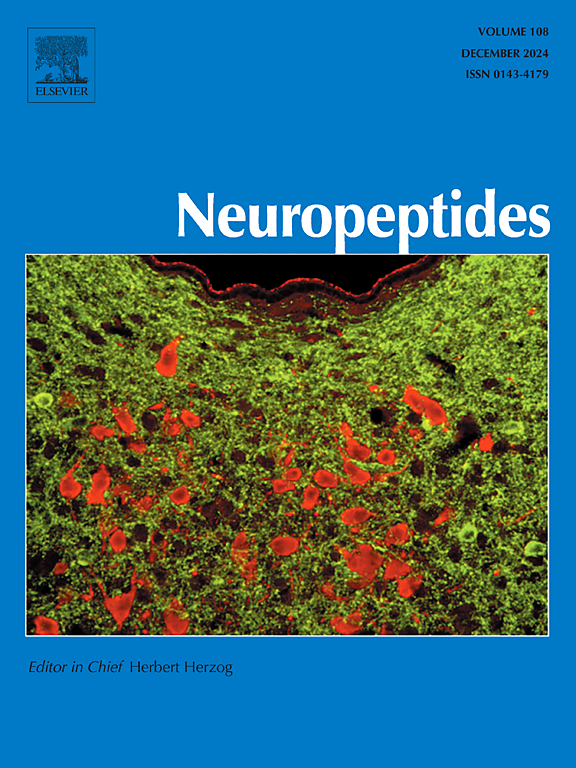Catestatin-like immunoreactivity in the skin and related sensory ganglia
IF 2.7
3区 医学
Q3 ENDOCRINOLOGY & METABOLISM
引用次数: 0
Abstract
Aim
The chromogranin A-derived peptide catestatin has previously been shown to be a constituent of the sensory innervation of the eye and dental pulp. The antibody used in these studies not only recognizes authentic catestatin but also larger molecules containing the sequence of catestatin. Therefore, the authors now aimed to explore whether there are additional molecular forms present in the rat skin, rat trigeminal ganglion and rat dorsal root ganglia apart from free catestatin.
Methods
Western blot analysis was performed in these tissues and and double immunofluorescence techniques in rat dorsal root ganglia.
Results
A very prominent band was found at approximately 50 kDa in the skin representing a middle-sized fragment containing the sequence of this peptide. Recently, the same result has been obtained in the dental pulp indicating that this fragment might represent a main molecular form in various other tissues of the body. It is likely of sensory nature since the band was also present of weaker intensity both in the trigeminal ganglion and dorsal root ganglia and since abundant cells expressed catestatin-like immunoreactivity in rat dorsal root ganglia. Another small sized fragment of weaker intensity was found in these tissues as well. No band was observed in the position of intact chromogranin A in the Western blot.
Conclusion
Chromogranin A is proteolytically processed in sensory ganglia to at least two fragments containing the sequence of catestatin which are then anterogradely transported to the skin and the 50 kDa fragment obviously becomes aggregated there in nerve endings.
皮肤及相关感觉神经节的catestatin样免疫反应性
目的嗜铬粒蛋白a衍生的肽catestatin先前已被证明是眼睛和牙髓感觉神经支配的组成部分。这些研究中使用的抗体不仅可以识别真正的catestatin,还可以识别含有catestatin序列的大分子。因此,作者现在的目的是探索除游离睾丸素外,大鼠皮肤、三叉神经节和背根神经节中是否存在其他分子形式。方法对这些组织进行western blot分析,并采用双免疫荧光技术对大鼠背根神经节进行检测。结果在皮肤约50 kDa处发现一个非常突出的条带,代表含有该肽序列的中等大小片段。最近,在牙髓中获得了相同的结果,表明该片段可能代表了身体其他组织的主要分子形式。由于在三叉神经节和背根神经节中也存在较弱强度的条带,并且由于大鼠背根神经节中大量细胞表达了catestin样免疫反应性,因此可能具有感觉性质。在这些组织中也发现了另一个较小的弱强度碎片。Western blot未观察到完整的嗜铬粒蛋白A位置出现条带。结论色粒蛋白A在感觉神经节中被蛋白水解成至少两个含有catestatin序列的片段,然后顺行转运到皮肤,50 kDa片段明显聚集在神经末梢。
本文章由计算机程序翻译,如有差异,请以英文原文为准。
求助全文
约1分钟内获得全文
求助全文
来源期刊

Neuropeptides
医学-内分泌学与代谢
CiteScore
5.40
自引率
6.90%
发文量
55
审稿时长
>12 weeks
期刊介绍:
The aim of Neuropeptides is the rapid publication of original research and review articles, dealing with the structure, distribution, actions and functions of peptides in the central and peripheral nervous systems. The explosion of research activity in this field has led to the identification of numerous naturally occurring endogenous peptides which act as neurotransmitters, neuromodulators, or trophic factors, to mediate nervous system functions. Increasing numbers of non-peptide ligands of neuropeptide receptors have been developed, which act as agonists or antagonists in peptidergic systems.
The journal provides a unique opportunity of integrating the many disciplines involved in all neuropeptide research. The journal publishes articles on all aspects of the neuropeptide field, with particular emphasis on gene regulation of peptide expression, peptide receptor subtypes, transgenic and knockout mice with mutations in genes for neuropeptides and peptide receptors, neuroanatomy, physiology, behaviour, neurotrophic factors, preclinical drug evaluation, clinical studies, and clinical trials.
 求助内容:
求助内容: 应助结果提醒方式:
应助结果提醒方式:


